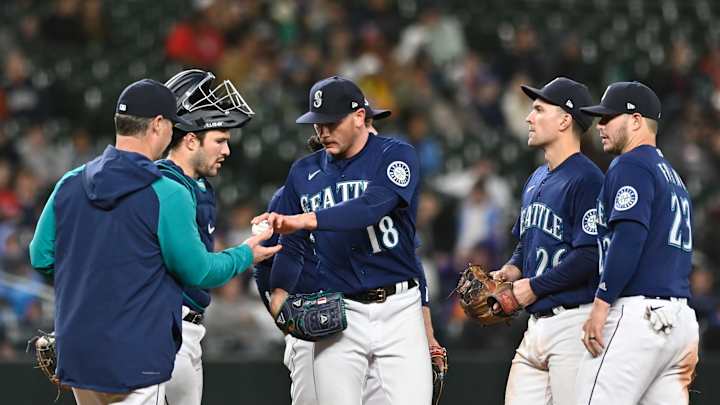Analysis: Mariners Bullpen's High-Leverage Woes and Why Scott Servais Isn't to Blame

In this story:
The Mariners had one of the best bullpens in baseball last year, but that has not carried over into the 2022 campaign. Through 48 games, the unit ranks 22nd in fWAR (0.4), 26th in win probability added (-1.43) and has suffered several key injuries and personal regressions from some of its key contributors a year ago.
These misfortunes are one of the main reasons Seattle has struggled to the tune it has thus far, going 10-17 in games decided by three runs or fewer. Mariners relievers have struggled mightily to both hold leads/ties and keep deficits to a minimum—the antithesis to their efforts in 2021.
Following the All-Star break last year, the Mariners featured a bullpen that allowed just 26 earned runs and a slash line of .218/.309/.388 in 54.1 high-leverage innings. Opponents registered a modest 29.6 percent hard-hit rate and posted the third-highest left-on-base percentage (55.1 percent) during that time.
Those numbers, however, have alarmingly crashed through 41 high-leverage situations this year. Opponents are slashing a whopping .299/.378/.506—all of which rank in the top-five of MLB—against Mariners relievers in those instances, recording the third-highest hard contact rate in the league (34.4 percent) and leaving men on base just 38.7 percent of the time.
There isn't one particular arm to point the finger of blame at either; the results are more or less unideal from top to bottom.
Of the 41 aforementioned high-leverage situations, Paul Sewald holds the biggest share at 4.1 innings pitched in seven appearances. While the regression gods have been less malevolent towards Sewald than his teammates, which has made him one of the few arms manager Scott Servais can realistically depend on right now, he's still had some bumps in the road.
This includes a disappointing outing against the Astros on Sunday, when Sewald inherited a tie ballgame with a runner on second and one out in the top of the eighth inning. Struggling to find his command of the strike zone, the 32-year old issued back-to-back walks to Michael Brantley and Alex Bregman before giving up a game-winning RBI single to Yordan Álvarez.
Aside from Sewald, 24 of the 34 remaining high-leverage appearances have been divvied up between Andrés Muñoz, Drew Steckenrider, Anthony Misiewicz, Yohan Ramírez, Matthew Festa and Penn Murfee, who've combined to allow 17 runs—15 earned—on 11 hits and five walks. Ramírez, of course, is no longer with the team after being DFA'd and later traded to the Guardians, while Steckenrider was recently demoted to Triple-A Tacoma. Muñoz, however, has been the biggest culprit in this group, accounting for eight of the 17 runs allowed.
Diego Castillo, Sergio Romo, Matt Koch and Erik Swanson claim ownership of Seattle's 10 other high-leverage appearances so far. Koch and Swanson went scoreless in their respective opportunities, but the former is back in Triple-A and the latter is currently recovering from right elbow inflammation. Romo has also recorded a scoreless inning's worth of work over two outings and will be a crucial asset for the team moving forward, thanks to his elite ability to generate weak contact.
Interestingly, despite his overall struggles this season, Castillo's numbers suggest he's been better than some may think. He's provided Seattle with 2.1 innings of high-leverage production in six total appearances, giving up two earned runs on a pair of hits and a walk. There is the obvious caveat of a very small sample size, but he leads the club with four high-leverage strikeouts, including two with a pair of runners in scoring position to secure a one-run win over the Mets, and may very well be the victim of bad luck and lackluster defense behind him, as supported by his 0.99 FIP contrasting his 7.71 ERA.
Still, the fact of the matter remains that Seattle has major issues in its bullpen and has not been good enough in other areas to make up for the unit's regression. Until Swanson is able to return, Sewald, Romo and—to a degree—Castillo appear to be the only relievers deserving of Servais and company's confidence.
Three reliable pieces out of what is typically an eight-man group is not a ratio the Mariners want to maintain for much longer if they can help it. Pieces will need to be added one way or another, whether or not the team's playoff aspirations survive the summer.
So while it's natural for fans to question the bullpen management skills of their favorite team's manager, particularly in high-leverage situations, the talent has to be there for the decisions to truly matter. Frankly, Servais doesn't have much to work with right now, and that's one of the biggest obstacles impeding the Mariners as a whole.
